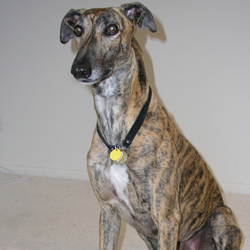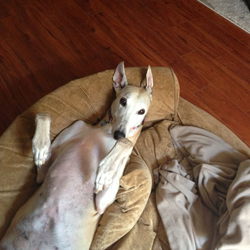TRAINING - BEHAVIOR: Leash Training

You envision a pleasant walk, your Greyhound strolling calmly beside you. Your Greyhound, however, seems to envision running 45 mph dragging you behind him as he conquers the neighborhood.
Your walk with your dog is the equivalent of the wolf pack’s “patrol” or “hunt.” It communicates relationship. In a wolf pack, the dog in front is choosing the speed and direction of the pack. Walking in front of the pack leader is a direct challenge to his leadership. When your dog leads you on a walk, he is using inbred doggie language to express leadership over you.
I’ve had dog owners ask, “But can’t the dog have time to freely explore or relieve himself?” Yes, it is fine to stop to let dog relieve himself or even just to sniff, but YOU decide when and where. You stop, say “ok,” and allow the dog to explore as far as the end of the leash. You remain in one spot. Once you decide it is time to move, you say “heal” or “walk” and bring the dog next to you. Any time you are moving, the dog should be next to you. You are choosing your speed and direction, not the dog.
How do you take control of the walk? Control begins long before you exit the house.
• Putting on the leash: If the dog is jumping, pawing, or barking as you maneuver to put on the leash, he is already controlling the situation. STOP. Turn your back to the dog and become a statue. Continue only once the dog has calmed down. If you start again to attach the leash and he again starts to jump, then you again turn into a statue. It is important that no progress happens as long as the dog is misbehaving. The first few times, it may take a few minutes for him to get the idea, and you may think that you will never get out the door. Be patient. Your control here will set the stage for your control on the walk.
• Going out the door: Again, in doggie language, the one in front is the one in control. Always exit the door in front of your dog, Stop at the door, say “Wait” and step through. Then allow him to follow. Don’t let him pull you out the door.
Now you are ready to walk. Control doesn’t require a strict, “dog’s nose-at-my-kneecap” position, but the dog should not be in front of you and, most importantly, should be focused on you.
You can teach your dog to walk next to you in a number of ways. Choose the method, or combination of methods, that works best for your dog. The important thing is to BE CONSISTENT. If you take leadership one day but not the next, you confuse your dog and you lose his confidence and respect.
1) Treat method: If your dog is food motivated, you may be able to teach walking with treats. Pull out the “high reward” treats, the special ones that the dog gets only when training. Make them very small, about the size of a piece of dry kibble, so you can give out lots of them without impacting his digestion or diet.
Have the dog on your left side and treats in your right hand (several treats in your fist, with one treat between your thumb and forefinger.) With your head up, facing forward, stretch your right arm across your body and place your right hand just above your left knee. Begin walking. Use the treat to lure the dog into the proper position. As the dog noses your hand, give him a treat. Continue feeding treats into your fingers from your fist and give enough rewards to keep the dog in the proper position. Over several days, slowly decrease the frequency of the rewards until the dog is walking beside you with little or no reward. The dog has learned to focus on you.
2) Leash method: The keys to teaching a dog to walk using the leash method are energy and effective correction.
You must exhibit leadership energy. This comes from within. Stand straight, head up, shoulders back, and face forward as you walk confidently. Don’t look at the dog. You set the pace; you set the direction; you simply expect the dog to follow your leadership.
If the dog pulls in front of you or off to one side, correct him. However, the correction must be done correctly or you confuse the dog. First, pull up and in, never pull back. Pulling back turns into a tug-of-war, and the dog will win. The purpose of the correction is to cause the dog to focus on you, not the surroundings. Second, the correction should be a snap and release. You may have to snap and release repeatedly (even every second or so), but holding the leash tight continues to correct the dog for being in the proper position. Correct quickly and stop: snap and release. Again, the purpose is to have the dog focus on you.
3) Turn method: This usually works best when used with one or both of the above methods and usually works best with dogs that are not overly excited or heavy pullers. To use the turn method, simply walk and any time the dog starts to step in front of you, turn sharply. Turn into the dog, blocking his path, or turn away from the dog, correcting him so he follows you. Sometimes you may even do a 180 degree turn. The frequent and sudden changes of direction force the dog to focus on you.
4) No-Pull Aids: A number of no-pull aids are available. Halti or Gentle Leader head collars place a strap around the dog’s nose. Pulling on the collar turns the head toward you, again, causing the dog to focus on you. CAUTION: Never sharply snap or yank on this type of collar. You can hurt the dog’s neck. Also, be sure the collar is fitted correctly and, especially with a Greyhound, always use your regular collar too in case the dog slips out of the head collar.
No-pull harnesses go around the dog’s chest and under the front legs. Pulling on these, cause the straps under the legs to tighten. While this may cause the dog to slow down, it does not teach the focus on you aspect of walking. CAUTION: The straps under the legs can quickly cause a rash or even a cut in the “armpits” if you are not careful.
Whatever method you use to gain control when walking with your dog, the benefits go far beyond making it a safe and pleasurable experience for both of you. Trainers often use proper leash training to address behavioral issues such as separation anxiety, dominance, fear, and even aggression.
When you are in control of the walk, you reaffirm your relationship as pack leader. Your dog enjoys the security of being guided and protected by the pack leader. He may now simply enjoy the walk rather than having to orchestrate the walk. The challenge of following your leadership provides not only physical exercise, but also a refreshing mental challenge for your dog.
by Bonnie Jeffers
Your walk with your dog is the equivalent of the wolf pack’s “patrol” or “hunt.” It communicates relationship. In a wolf pack, the dog in front is choosing the speed and direction of the pack. Walking in front of the pack leader is a direct challenge to his leadership. When your dog leads you on a walk, he is using inbred doggie language to express leadership over you.
I’ve had dog owners ask, “But can’t the dog have time to freely explore or relieve himself?” Yes, it is fine to stop to let dog relieve himself or even just to sniff, but YOU decide when and where. You stop, say “ok,” and allow the dog to explore as far as the end of the leash. You remain in one spot. Once you decide it is time to move, you say “heal” or “walk” and bring the dog next to you. Any time you are moving, the dog should be next to you. You are choosing your speed and direction, not the dog.
How do you take control of the walk? Control begins long before you exit the house.
• Putting on the leash: If the dog is jumping, pawing, or barking as you maneuver to put on the leash, he is already controlling the situation. STOP. Turn your back to the dog and become a statue. Continue only once the dog has calmed down. If you start again to attach the leash and he again starts to jump, then you again turn into a statue. It is important that no progress happens as long as the dog is misbehaving. The first few times, it may take a few minutes for him to get the idea, and you may think that you will never get out the door. Be patient. Your control here will set the stage for your control on the walk.
• Going out the door: Again, in doggie language, the one in front is the one in control. Always exit the door in front of your dog, Stop at the door, say “Wait” and step through. Then allow him to follow. Don’t let him pull you out the door.
Now you are ready to walk. Control doesn’t require a strict, “dog’s nose-at-my-kneecap” position, but the dog should not be in front of you and, most importantly, should be focused on you.
You can teach your dog to walk next to you in a number of ways. Choose the method, or combination of methods, that works best for your dog. The important thing is to BE CONSISTENT. If you take leadership one day but not the next, you confuse your dog and you lose his confidence and respect.
1) Treat method: If your dog is food motivated, you may be able to teach walking with treats. Pull out the “high reward” treats, the special ones that the dog gets only when training. Make them very small, about the size of a piece of dry kibble, so you can give out lots of them without impacting his digestion or diet.
Have the dog on your left side and treats in your right hand (several treats in your fist, with one treat between your thumb and forefinger.) With your head up, facing forward, stretch your right arm across your body and place your right hand just above your left knee. Begin walking. Use the treat to lure the dog into the proper position. As the dog noses your hand, give him a treat. Continue feeding treats into your fingers from your fist and give enough rewards to keep the dog in the proper position. Over several days, slowly decrease the frequency of the rewards until the dog is walking beside you with little or no reward. The dog has learned to focus on you.
2) Leash method: The keys to teaching a dog to walk using the leash method are energy and effective correction.
You must exhibit leadership energy. This comes from within. Stand straight, head up, shoulders back, and face forward as you walk confidently. Don’t look at the dog. You set the pace; you set the direction; you simply expect the dog to follow your leadership.
If the dog pulls in front of you or off to one side, correct him. However, the correction must be done correctly or you confuse the dog. First, pull up and in, never pull back. Pulling back turns into a tug-of-war, and the dog will win. The purpose of the correction is to cause the dog to focus on you, not the surroundings. Second, the correction should be a snap and release. You may have to snap and release repeatedly (even every second or so), but holding the leash tight continues to correct the dog for being in the proper position. Correct quickly and stop: snap and release. Again, the purpose is to have the dog focus on you.
3) Turn method: This usually works best when used with one or both of the above methods and usually works best with dogs that are not overly excited or heavy pullers. To use the turn method, simply walk and any time the dog starts to step in front of you, turn sharply. Turn into the dog, blocking his path, or turn away from the dog, correcting him so he follows you. Sometimes you may even do a 180 degree turn. The frequent and sudden changes of direction force the dog to focus on you.
4) No-Pull Aids: A number of no-pull aids are available. Halti or Gentle Leader head collars place a strap around the dog’s nose. Pulling on the collar turns the head toward you, again, causing the dog to focus on you. CAUTION: Never sharply snap or yank on this type of collar. You can hurt the dog’s neck. Also, be sure the collar is fitted correctly and, especially with a Greyhound, always use your regular collar too in case the dog slips out of the head collar.
No-pull harnesses go around the dog’s chest and under the front legs. Pulling on these, cause the straps under the legs to tighten. While this may cause the dog to slow down, it does not teach the focus on you aspect of walking. CAUTION: The straps under the legs can quickly cause a rash or even a cut in the “armpits” if you are not careful.
Whatever method you use to gain control when walking with your dog, the benefits go far beyond making it a safe and pleasurable experience for both of you. Trainers often use proper leash training to address behavioral issues such as separation anxiety, dominance, fear, and even aggression.
When you are in control of the walk, you reaffirm your relationship as pack leader. Your dog enjoys the security of being guided and protected by the pack leader. He may now simply enjoy the walk rather than having to orchestrate the walk. The challenge of following your leadership provides not only physical exercise, but also a refreshing mental challenge for your dog.
by Bonnie Jeffers










